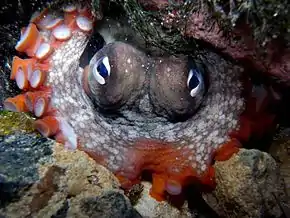Octopus tetricus
Octopus tetricus, the common Sydney octopus,[3] is a species of octopus from the warmer waters of eastern Australia and New Zealand.[2]
| Octopus tetricus | |
|---|---|
 | |
| Scientific classification | |
| Kingdom: | Animalia |
| Phylum: | Mollusca |
| Class: | Cephalopoda |
| Order: | Octopoda |
| Family: | Octopodidae |
| Genus: | Octopus |
| Species: | O. tetricus |
| Binomial name | |
| Octopus tetricus | |
| Synonyms[2] | |
|
Octopus gibbsi O'Shea, 1999 | |
Description
Octopus tetricus is normally coloured grey to mottled brown with rufous arm faces that taper towards the tip. Their eyes are typically white in colour, and the skin has many small regular shaped patches and large warty structures which are used by the octopus to make it look spiky, which are used by the octopus when it is camouflaging itself as seaweed.[3] The adults typically have an arm span of 2 metres (6.6 ft).[4]
Distribution
Octopus tetricus is distributed in the subtropical seas of eastern Australia and northern New Zealand, including Lord Howe Island. At similar latitudes in Western Australia a closely related species or subspecies is found.[3]
Habitat and behaviour
Octopus tetricus occurs in the intertidal zone along rocky shores and in the ocean and it has been suggested that this species is associated more commonly with rocky reefs during the breeding season, although they frequent areas of the sea bed with soft-sediments for much of their life.[3] It is primarily a nocturnal feeder which uses its sharp beak to feed on crustaceans and molluscs, for example sea snails and bivalves. It has also been recorded as being cannibalistic.[3]
It is a territorial species which sits out the day in a lair among rocks and rubble, the rubble being collected to create a defensible lair. The lairs of this species can be identified by the shells of the octopus's prey which it scatters around its home. They move about the rocks by crawling using their arms but they can use their siphon to propel themselves through the water by generating a jet of water.[3] The females lay many 1-2mm eggs which are attached to the roof of a rock crevice in strings and these hatch into planktonic baby octopodes. The females of O. tetricus have been known to cannibalise the males following mating.[3]
Two areas in Jervis Bay where they congregate have been dubbed Octopolis[5] and Octlantis,[6] containing a large area of discarded shells where ten or more octopuses den and mate.[7][8]
Fisheries
Octopus tetricus may be caught as bycatch in trawl and lobster-pot fisheries and is then sold for both human consumption and for use as bait.[3]
References
- "ITIS standard report - Octopus tetricus (Gould, 1852)". Integrated Taxonomic Information System. Retrieved 12 October 2014.
- "Octopus tetricus Gould, 1852". World Register of Marine Species. Vlaams Instituut voor de Zee. Retrieved 29 January 2017.
- "Common Sydney Octopus – Octopus tetricus". Australian Museum. 2012. Retrieved 29 January 2018.
- "Atlas of Living Australia - Octopus tetricus (Gould, 1852)". Atlas of Living Australia. Retrieved 26 October 2014.
- Godfrey-Smith, Peter; Lawrence, Matthew (October 8, 2012). "Long-term high-density occupation of a site by Octopus tetricus and possible site modification due to foraging behavior". Marine and Freshwater Behaviour and Physiology. 45 (4): 1–12. doi:10.1080/10236244.2012.727617.
- Scheel, David; Chancellor, Stephanie; Hing, Martin; Lawrence, Matthew; Linquist, Stefan; Godfrey-Smith, Peter (September 1, 2017). "A second site occupied by Octopus tetricus at high densities, with notes on their ecology and behavior". Marine and Freshwater Behaviour and Physiology. 50 (4): 285–291. doi:10.1080/10236244.2017.1369851.
- Douglas Main (28 January 2016). "Octopuses More Social Than Thought, Denizens of 'Octopolis' Prove". Newsweek. Retrieved 14 September 2017.
- Erik Stokstad (13 September 2017). "Scientists discover an underwater city full of gloomy octopuses". Sciencemag. Retrieved 14 September 2017.